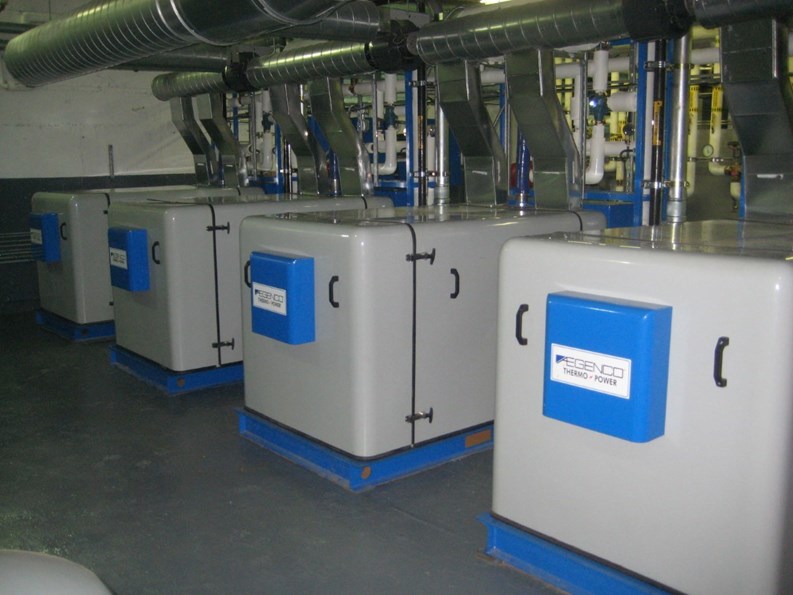Blizzards. Ice Storms. Hurricanes. Floods. New Yorkers are used to being buffeted by Mother Nature. But increasingly, it seems, the impact of such storms has lingered long after the weather front blows through, with hundreds or thousands or even millions of residents left in the dark. Beyond the inconvenience—the loss of modern-day necessities like television and air-conditioning—power outages can wreak havoc on condominium residents left in the dark. According to the Eaton Corporation’s blackout tracker, last year in New York,10,918,400 residents were affected by 159 outages.
In times of emergency, like a power outage due to foul weather or a fire in the building, certain aspects of many multifamily structures must function properly; steps must be free and clear so people can use them, and doors to stairways must function. In larger buildings, common areas, corridors and elevators usually are illuminated through the power provided by an emergency generator.
“Last year in the United States over 40 million people lost power and New York City was hit particularly hard during Hurricane Irene. When Irene hit New York City on August 28, power was knocked out for more than one million New Yorkers,” says Gary Moody of Silent Standby Power Supply LLC, a nationwide distributor of battery powered generators. From August 20-29, 2011, Hurricane Irene barreled through the Caribbean and the entire Eastern Seaboard, causing 56 deaths and widespread destruction accounting for nearly $19 billion in damages.
“This is nothing new—power goes out all the time—but in the worst-case scenario of power outages, it can be life threatening.”
Some commercial high-rise buildings have backup power to service the elevators when power goes out but it’s not required. Some larger New York City co-ops and condos, like Co-op City, Penn South and North Shore Towers, have even installed co-generation plants and have emergency power backup in case of an outage. However, according to the New York City Department of Buildings, the building code doesn’t require residential buildings to have emergency power backup.
Powering Up
There are two kinds of generators a building’s staff might use in a power outage: stationary sets or portable sets. A portable generator could be used by the staff of the building during an emergency or during construction work, if the structure does not have a stationary set. Portable sets vary widely in quality, and can last anywhere from four to ten years. The generating capability of stationary sets in residential buildings can range from 60 kilowatts to 3,000 kilowatts.
“A building would want to maintain power to critical systems that would allow the building to operate,” says Joe Cafiero of Control Electrical Contracting Corp. in Staten Island, “Such as elevators, public light and power, fire alarm system, PA systems, intercom systems, HVAC, boilers and domestic water pumps or any other type of pump for sewage and ground water.”
How long a generator lasts is partly dependent upon how much it is used and how well it is maintained, adds Cafiero. “With the proper maintenance generators can operate reliably as long as any vintage car. Some older generators can be re-built in place extending their life indefinitely,” he says. “Generators should be tested during a regular schedule of maintenance. Maintenance should occur at least bi-annually, if not quarterly. The generator should be allowed to run quarterly and be tested under load annually.”
Testing the unit and running it will prevent the gas in it from going bad prematurely, and will alert maintenance employees to any problems with the machine. A couple of time per year, a manufacturer’s representative of the generator’s maker should come to the building and thoroughly test the generator.
If a generator with an automatic transfer switch is well-maintained, when the lights go out it will turn on and provide emergency power to certain systems in the building. Which systems it powers is a question of what is required, and what residents want.
“Our systems can be operated in one of two ways,” says Moody, whose company manufactures a line of battery powered indoor generators. “One way is to simply plug in an item or items into it and it doesn’t require any electrical to work. The other way is to have it wired into an electrical panel and it will automatically turn on when the power goes out. With our generators the batteries are the gas tank and they store the energy.”
How powerful the generator is that a building’s board picks for installation depends upon various factors—some legal, and others, lifestyle-based.
“On site generators will go on automatically under a blackout or power outage condition,” says Cafiero, “But it might come on during a ‘brownout’ if the voltage dips below a voltage that is unsafe for equipment to operate at.”
Stationary emergency generators that are installed in multifamily buildings typically are either diesel fuel powered units, or natural gas powered units. Natural gas powered generators are connected by a line to the natural gas utility’s system. Because of its reliability, natural gas is considered a 100 percent (uninterruptable) power source for a generator, since the natural gas system is rarely interrupted.
Diesel fuel powered generators need to have surplus fuel on-site in order to operate. To be ready in the event of an emergency, the building’s staff also must have the generator gassed up. Usually a residential building’s generator will be used for no more than a few days at a time, meaning that enough fuel to run it for that long will be stored on-site.
Stationary standby generators often are located in the basement of a building, near the furnace room, in a room specifically created for the generator. In other cases, these units are situated outside the building on a concrete pad, near the transformer. Sometimes stationary generators are set up on a building’s roof, and in smaller buildings, the generator sometimes is located in the garage.
A battery-powered indoor generator comes fully charged. The charge is stored in a bank of batteries and available for immediate and easy use when you need it. Everything plugged into the units outlets will be powered upon loss of power. With battery-operated generators there is usually no gas, noise or fumes. These battery systems will not run air conditioners in condos. Silent Standby Power’s Indoor Generator products retail from $3,000 to $7,500, depending on what needs power and for what length of time.
Maintenance Required
“Gas generators typically require more maintenance than battery-operated generators,” says Moody. “With a battery-operated generator there are no moving parts.”
These emergency units do not need to be warmed up before reaching full capacity. Larger, liquid-cooled generators usually have an engine block heater which keeps the block warm and ready to go. Such generators automatically start if the utility fails, and automatically switch off when utility power returns.
“Generators aren’t normally switched on. The conditions that cause the generator to operate are usually dictated by the transfer switch that it is connected to,” says Cafiero. “The transfer switch is what switches the normal power source to the generator ‘emergency’ power source. When a power outage occurs a regularly maintained generator will start and come up to running speed inside twenty seconds. Once the transfer switch detects that the generator is producing a safe operating voltage the power will be switched over and restored through the emergency power source.”
Professional Help
Perhaps because generators are usually unseen and often unrecognized, the absolute necessity of them is lost on some residents of multifamily buildings. While keeping some of a high-rise building’s lights on and its elevators running during a power outage might seem to be a convenience to some able-bodied people, disabled people and some elderly people with mobility problems truly need the elevators to work so that they can get out of the building safely. For some people, having an emergency system in place can be a lifesaver.
Though installing a generator in a multifamily building can be a costly project, it’s a solution some buildings choose to implement. The power generation needs required of such a unit also usually are simple. That means in most cases, the generator will be expected to provide power for common areas, garage doors and elevators. Sometimes, a building’s generator also will provide power for heat, refrigerators and lights in the structure’s apartments—but residents will pay a premium for the extras.
When planning to install an emergency generator in a residential building, the building’s board members and staff must first ask the experts how to proceed. Usually, this means hiring a consulting engineer or an architect to oversee the process, beginning with a review of the building’s emergency power generation needs. Based upon that evaluation, the engineer will determine how large the building’s generator should be. Next, the engineer designs the necessary transfer switches for the generator, as well as a room in the building (or exterior/roof space) in which to locate the generator.
The process includes the designer, as well as a general contractor, an installing contractor, the co-op or condo board, the manufacturer, and the local distributor who supplies the equipment. Usually, the design consultant will offer to write up a Request for Proposals document (which describes the parameters of the generator installation project), and distribute it to electrical contractors so they can bid on the job. The board may hear the consultant’s recommendation for which contractor to use for the job, and then the group will vote and choose the contractor. That general contractor will ensure that the installation project meets all safety requirements.
The laws that govern the use of generators in multifamily communities vary from place to place. But questions regarding the generator’s operation can include where it will be placed, noise created by the unit, and the storage of fuel (for diesel generators). Some local building codes require a generator if a building is above a certain height (for elevators and fire pumps, for example), while others do not.
The architect and installing contractor will work together to determine the proper size generator, the type of generator and where it is placed. These determinations could require analysis of the building’s roof structure, ventilation system, the concrete pad’s size and strength, the fuel source for the generator (gas lines or size of diesel fuel tank), and the fresh air intake for the unit.
“The only dangers associated with having a generator is from the power source,” says Cafiero. “The natural gas or gasoline that powers the generator must be installed properly in order to limit the risks. A well-maintained generator that is installed properly and within code should operate safely and reliably for many years.”
Jonathan Barnes is a freelance writer and regular contributor to The Cooperator. Staff Writer Christy Smith-Sloman contributed to this article.







Comments
Leave a Comment